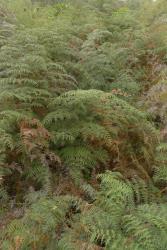- = Cincinalis Gled., Syst. Pl. stamin. situ 290 (1764)
- = Pteris sect. Ornithopteris J.Agardh, Recens. Spec. Pter. 45 (1839)
- ≡ Ornithopteris (J.Agardh) J.Sm., Hist. Fil. 297 (1875) nom. illeg., non Ornithopteris Bernh. 1805
Terrestrial ferns. Rhizomes long-creeping, bearing multicellular hairs. Fronds monomorphic. Stipes hairy. Laminae 2–5-pinnate, coriaceous, bearing non-glandular hairs; primary pinnae stalked, sometimes with reduced stipule-like basal pinnules. Veins free except for a marginal connecting vein. Sori more or less continuous around the lamina margin borne on the connecting vein, superficial; paraphyses absent. Outer indusium formed from the reflexed membranous lamina margin, opening inwards; inner indusium poorly developed or absent. Spores trilete, irregularly granulate.
Pteridium is clearly defined and forms a clade along with Paesia, Saccoloma, Histiopteris and Blotiella within Dennstaedtiaceae (Perrie et al. 2015). It is a worldwide genus variously interpreted as having a single species with two subspecies and a number of varieties (Tryon 1941; Page 1976; Tryon & Tryon 1982; Kramer 1990), or perhaps four closely related species and several subspecies (Brownsey 1989, 1998; Der et al. 2009; Thomson 2012; Zhou et al. 2014). Recent analyses of sequence data suggest that there are two major diploid clades corresponding to P. aquilinum in the Northern Hemisphere and Africa, and P. esculentum in South America, Australia, New Zealand and south-east Asia. There is also evidence for two allotetraploid species – P. semihastatum in northern Australia and south-east Asia, and P. caudatum in Central and South America (Thomson & Alonso-Amelot 2002; Der et al. 2009; Zhou et al. 2014). However, some authors have continued to recognise additional species in South America (Schwartsburd et al. 2014) and China (Liao et al. 2013).
Pteridium can be recognised by its long-creeping rhizomes, highly divided laminae bearing non-glandular hairs, and sori that are more or less continuous around the lamina margins protected by the inrolled lamina margin and a poorly developed inner indusium.
A subcosmopolitan genus interpreted here as having four closely related species and several subspecies. There are two species in Australia (Brownsey 1989, 1998) and one in the Pacific. One non-endemic species in New Zealand.
| Category | Number |
|---|---|
| Indigenous (Non-endemic) | 1 |
| Total | 1 |
The base chromosome number in Pteridium is x = 26 (Brownsey 1983; Kramer 1990).




